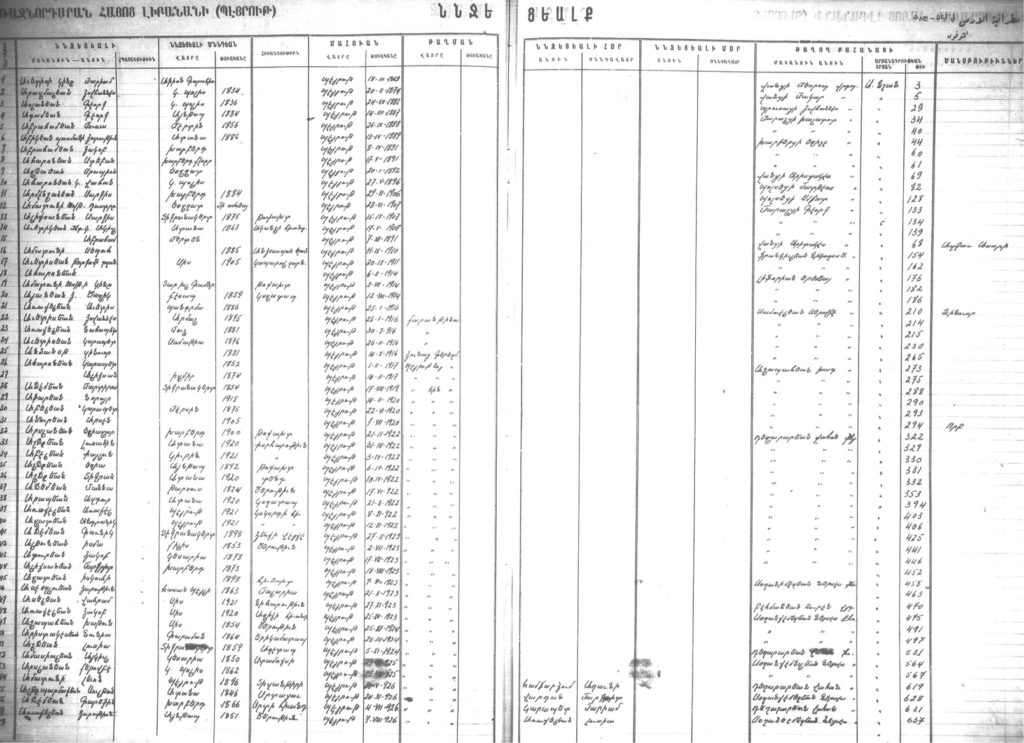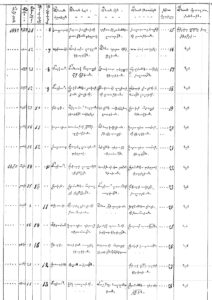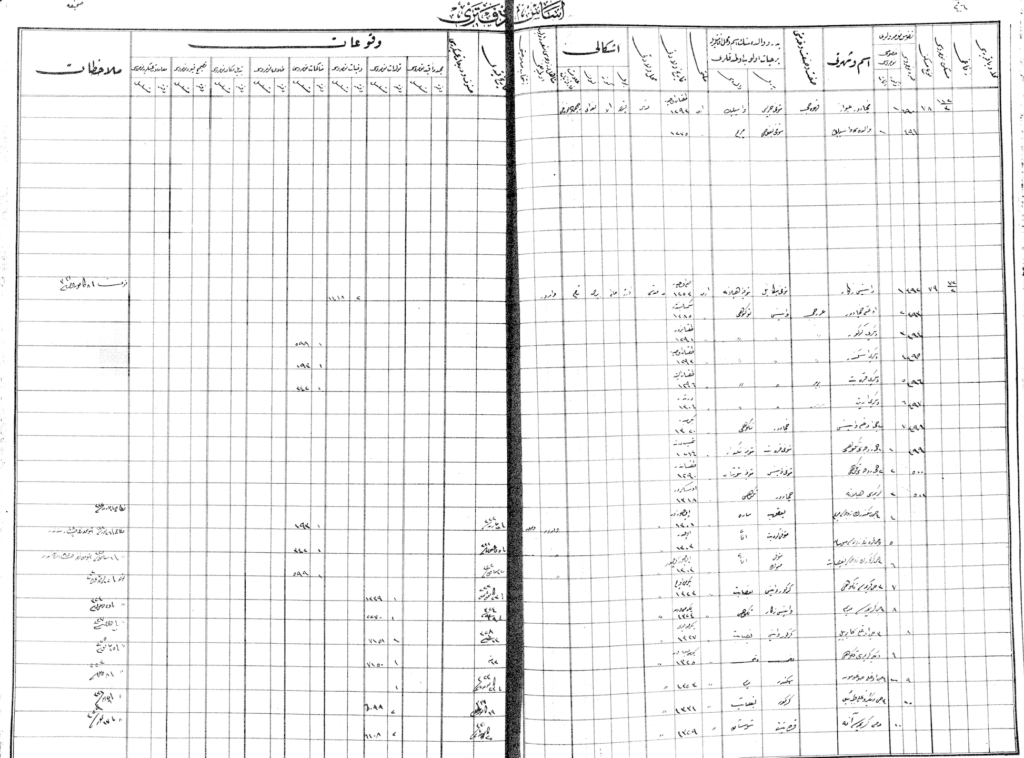This article is part of a continuing series documenting the available records for research into one’s Armenian family roots. Part I in the series supplied a historical background on the Armenian genealogy movement as well as specific records available for Syria. In Part 2, records from Lebanon and Israel will be detailed.
Lebanon
Similar to Syria, the Armenian community of Lebanon has its origins prior to the genocide. Though, in general, very few Armenian church records have come to light for periods prior to 1800. The destruction caused by the genocide does not completely explain the absence of such records. Neglect may be the most reasonable additional explanation. One only has to imagine what will be available a century or more into the future from our church records today, and we live in an age where preservation is more easily achievable.

The LDS Family History Library contains a copy of the midwife records from Beirut. However, the catalog reference on FamilySearch.org is incomplete. The records actually begin in Aintab and then continue to Aleppo with the relocation of the women serving as midwives. While unique and culturally important, from a genealogical perspective they are limited. Still, a child’s date of birth and the choice of words to identify a family are both interesting and informative. For example, on Jan. 2, 1897, the daughter-in-law of Besnili (from town of Bresni in Adiyaman district) Kecheji (felt maker) Krikor gave birth to a boy.
Thus far, I have not worked with or identified the location of Ottoman-era population registers for regions now part of Lebanon. However, Armenian church records are available through the LDS Family History Library. A number of mortality studies made use of these and other records in the LDS collection. The driving force behind these important studies, published in the 1980s and 1990s, was Haroutune K. Armenian.
The earliest records begin in 1863 for St. Nshan church in Beirut. These early records indicate the infrequent occurrence of sacraments. As I peruse the register, the family groupings become apparent quickly. For instance, on Jan. 12, 1879, Hampartsoum Choporian/Chopourian from Agn married Yeghisapet from Agn. On June 2 of the following year, their daughter Vartouhi was baptized.
While the sacramental records continue through approximately 1980, there are also three church censuses included in the available records. Though I have not had the opportunity to view these, the censuses date from 1949, 1970 and 1980. Also available are the sacramental records of a number of other parishes from around Lebanon. The catalog on FamilySearch.org details these resources as well.

One of the nice features of the church records from Lebanon is the existence of baptism, marriage and funeral indexes. The indexes are alphabetical according to the first initial of the surname and then within each letter the records are organized chronologically. The baptism index begins in 1903, while the marriage index in 1934 and the funeral index in 1869.
In looking through the indexes, I happened to find a reference to a likely relative of mine. The funeral for Srabion Aghjayan was held on 20 Jan 1892 in Beirut. As he was shown to be from Yozgat, combined with the uniqueness of my surname, the probability of our relationship is rather high.
Israel
The Armenian community of Palestine, and Jerusalem in particular, dates back centuries. The available records for this region offer unique opportunities not possible elsewhere.

Once again, the LDS Family History Library contains copies of vitally important records. There are parish registers for both the Armenian Apostolic Church as well as the Armenian Catholic Church. On FamilySearch.org, one needs to search each location separately (e.g. Jerusalem, Tel-Aviv, Nazareth, Bethlehem).
The sacramental records of St. Nigoghayos (Tel-Aviv) beginning in 1844 and the Jerusalem Patriarchate beginning in 1838 are available. The Armenian Catholic church records are available for the years since the Armenian Genocide. Additionally, the sacraments as well as the history of the Armenian monastery at the Church of the Nativity in Bethlehem have been microfilmed.
One particularly interesting resource is the register of visiting pilgrims to Jerusalem. The register begins in 1872 and lists the head of each party, where they were from, the number of people traveling in the party, and how much was donated.
While the above records are each important in their own right, what makes Israel truly unique is the availability of late-Ottoman population registers. While in other locations, the Ottoman registers are only available for years prior to 1860, in the case of Palestine, they are available up to 1917 in some cases. This allows for analysis of the quality of the information in ways previously not thought possible.
A recent query from someone on the Armenian Genealogy Facebook group prompted a rekindling of my interest in the Jerusalem records. The search for the answer serves as a wonderful example of what is possible.
Mikayel the tailor (derdzak or terzi), son of Hovhannes, was known by Zakarian and was born in the early 1800s in Jersualem. Prior to the available records from the Jerusalem church, he married Heghine Aprahamian from Beirut. Exactly how many unrecorded children were born to this marriage is unknown, but on Jan. 18, 1849, a son, Khachadour, was baptized. In addition, we can find the baptism for another son, Krisdosdour, on Aug. 3, 1852. We know of another son, Hovhannes, from his marriage on Oct. 14, 1866, to Takouhi Garabedian. From these and other records, we do not know the origin of the surname Zakarian, possibly the Mikayel’s paternal grandfather was named Zakar or Zakaria. With each new generation, the church records would refer to Mikayelian, Hovhannesian, Krisdosdourian, etc. while the family to this day still goes by Zakarian.

The unique aspect of this example is that beyond the church records, the family can be identified in the Ottoman population registers. Thus, we are able to gain insight into the record keeping process of both the Armenian church and Ottoman officials to better understand the strengths and weaknesses of each.
The first Ottoman population register dates to approximately 1881-82 with information continually added over the next 20 years. At the time the register was created, the patriarch of the clan was Mikayel and from this record we learn his father’s name, approximate year of birth (1812) and birthplace (Jerusalem). The household would grow to 21 people. We also learn that his wife, Heghine, was born around 1815, though the register misstates her birthplace as Jerusalem.
The household includes two sons and two daughters of Mikayel and Heghine, but their son Khachadour is not listed. From the church records, we can confirm Khachadour passed away in 1864 at the age of 18. This would place his funeral not quite 16 years after his baptism implying he was over a year old at baptism which would be very uncommon.

The second Ottoman population register continues the information on the family through 1914. By this time, Mikayel and Heghine had passed away and the family had grown to require two households, one headed by Hovhannes and the other by Krisdosdour.
There are Ottoman birth, marriage, divorce, and death registers that supplement the latter population register as well. I have only touched upon the possibilities here; a more thorough study is required to fully appreciate the over 100 years of documentation for this one family and others like them with roots in Jerusalem.
Author information
The post Research Your Armenian Roots—What You Need to Know (Part II) appeared first on The Armenian Weekly.
Source: Armenian Weekly
Link: Research Your Armenian Roots—What You Need to Know (Part II)
